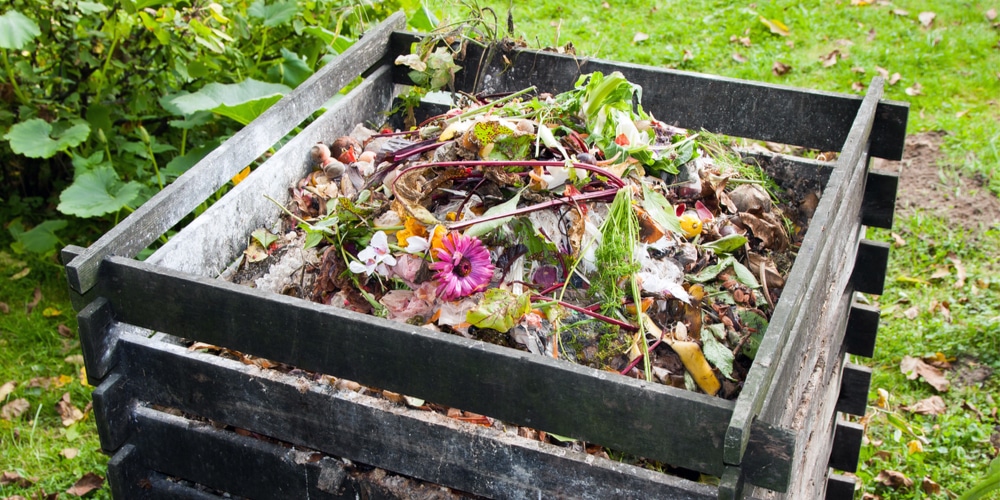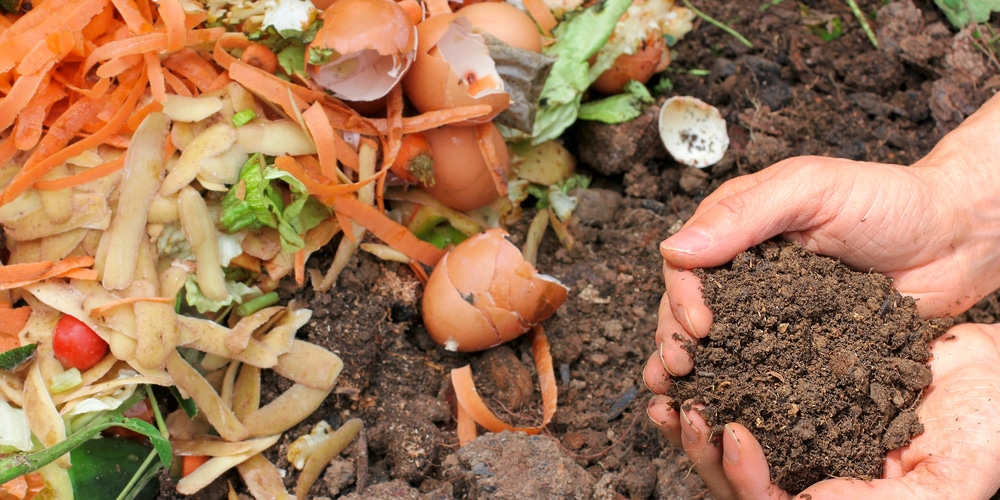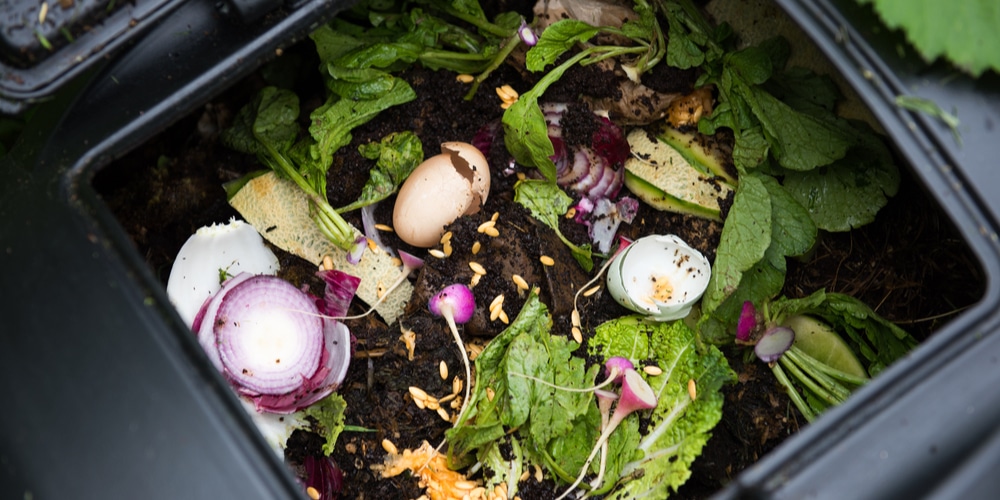Greetings Flatlanders! Welcome to our IL composting guide. I’m from Missouri, but the basics are the same. Let’s get to it!
Understanding Composting Basics
Composting is the natural process of recycling organic matter, such as leaves and food scraps, into a valuable fertilizer that can enrich soil and plants.
By starting your own compost heap, you contribute to a healthier environment by reducing landfill waste.
What You Will Need:
- Space: A spot in your yard that is at least 3 feet wide.
- Compost Bin: Purchase or build your own bin.
- Materials: Carbon-rich “browns” (e.g., dry leaves, branches) and nitrogen-rich “greens” (e.g., vegetable scraps, grass clippings).
Getting Started:
- Location: Choose a partially sunny area for proper heat and shade balance.
- Layering: Begin with a layer of browns, followed by a layer of greens.
- Layering (cont.): Aim for a ratio of about 3:1 (browns to greens).
- Moisture: Your pile should be moist, but not drenched, to aid in the decomposing process.
Maintenance:
- Aerate: Turn the pile every couple of weeks to inject oxygen and speed up decomposition.
- Balance: Adjust your green and brown layers if the pile is too dry or too wet.
Setting Up Your Composting Area
Starting your composting journey in Illinois involves two critical steps: selecting an appropriate composting method and finding the ideal spot for your compost pile or bin.
Selecting a Composting Method
In-Vessel Composting: You can use a tumbler or a closed bin to compost. This method is tidy, keeps pests at bay, and is suitable for small spaces.
Open Piles or Bins: An open compost pile or a bin with no bottom allows direct contact with the soil, making it easier for organisms to assist in breaking down the compost.
Pit Composting: Digging a pit or trench in your yard and burying organic waste is a more passive form of composting. However, this method may take longer to decompose materials.
Vermicomposting: Utilize red wigglers or other composting worms to break down your kitchen scraps in a process known as vermicomposting. It’s an excellent indoor option.
Choosing the Right Location
- Sun Exposure: Your compost should be placed in an area with good sunlight as warmth accelerates the composting process. However, too much sun can dry out your compost.
- Accessibility: Keep it close enough to your home for convenience but not too close that any odors become a problem.
- Drainage and Aeration: Set up on well-draining soil. If possible, provide aeration by resting the pile on branches or a pallet.
- Flat Ground: A level area prevents the compost pile from shifting and facilitates easier access for turning the compost.
- Water Source: Your compost will need moisture, so a nearby water source saves time and effort.
Gathering Compostable Materials
Successful composting in Illinois starts with understanding what to toss into your compost bin. You’ll be balancing two types of organic materials, greens and browns, to create an ideal environment for decomposition.
Greens and Browns
Greens are nitrogen-rich materials, and they’re crucial for jumpstarting the composting process. These items typically include:
- Vegetable and fruit scraps
- Coffee grounds and filters
- Fresh grass clippings
- Plant trimmings
Browns provide carbon, helping create the bulk of your compost. Your brown materials might consist of:
- Dry leaves
- Twigs and branches
- Cardboard and paper (shredded)
- Straw and hay
Aim for a ratio of about 3:1, browns to greens, to maintain a balanced compost pile.
Items to Exclude from Your Compost
Not everything can go into your compost pile. To prevent pests, odors, and potential plant diseases, steer clear of these materials:
- Meat and dairy products
- Fats and oils
- Diseased plants
- Pet waste
Maintaining Your Compost Pile
Maintaining your compost pile requires attention to material balance, moisture levels, and regular monitoring to ensure it decomposes properly into rich, beneficial compost.
Balancing Materials
For a healthy compost pile, you need a mix of green (nitrogen-rich) and brown (carbon-rich) materials. Aim for a ratio of approximately 3:1, favoring browns over greens.
- Green materials include vegetable peelings, fruit waste, and lawn clippings.
- Brown materials encompass dry leaves, branches, and cardboard.
Keep these components balanced to avoid odors and attract the proper microorganisms.
Moisture and Aeration
Your compost pile should have the moisture content of a wrung-out sponge, generally maintained by rainfall or occasional watering.
If your compost is too dry, microbial activity slows down; if it’s too wet, it becomes anaerobic and smelly.
To ensure even aeration and moisture:
- Turn your pile every week to increase oxygen supply.
- Check moisture levels during dry spells and water if necessary.
Monitoring Compost Progress
Monitor your compost’s progress by observing changes in the material’s consistency and volume. Over time, materials will shrink and become darker as they decompose.
- Look for earthy-smelling, dark brown, and crumbly texture; this indicates your compost is ready.
- Use a compost thermometer to check the pile’s core temperature, which can indicate activity level—compost should maintain a temperature between 140-160°F during active decomposition.
Using Finished Compost
Once your compost has matured and turned into a dark, crumbly substance with an earthy aroma, it’s ready to be used in your garden and landscaping. Here’s how to make the most of your finished compost in Illinois:
Gardening: Work the compost into your garden beds to improve soil structure and provide nutrients. Aim for a mix of up to 3 inches of compost into the top 6 to 8 inches of soil.
Potting Mix: When potting plants, blend compost with soil or a soilless mix to create a nutritious environment for your container gardens. A good ratio is 1 part compost to 2 parts potting mix.
Top-Dressing: Sprinkle compost around the base of your plants as a top-dressing to slowly integrate nutrients into the soil. It also acts as a mulch, helping to retain moisture and suppress weeds.
Lawn Care: For lawn areas, aerate your grass first, then spread a thin layer of compost to encourage a lush and healthy lawn.
| Application | Amount | Method |
|---|---|---|
| Garden Beds | 2-3 inches | Mix into the soil |
| Potting Mix | 1:2 compost to potting mix | Blend together |
| Top-Dressing | 1/2 inch | Spread around plants |
| Lawn Care | 1/4 inch | Spread after aeration |
Frequently Asked Questions
Below are targeted answers to common questions that can help you start your composting journey effectively. Whether you reside in a detached home with a garden or a small apartment in Illinois, these pointers are crafted to assist you in cultivating a robust composting practice.
What are the essential steps to start home composting?
To begin home composting, select a suitable spot on bare soil for your bin, ensuring it has partial sunlight and is well-drained.
Start by adding alternating layers of ‘greens’ (nitrogen-rich material like vegetable peelings) and ‘browns’ (carbon-rich material such as leaves).
What materials are necessary for beginning a compost pile?
Your compost pile requires a balance of greens, like kitchen scraps and yard waste, and browns, such as dry leaves and cardboard.
A compost bin or pile, a pitchfork or a similar tool for turning the compost, and water are also essential to maintain moisture.
How should kitchen scraps be composted by beginners?
For kitchen scraps, keep a container handy to collect materials, avoid meat or oily waste to prevent odors and pests, and bury the scraps in the center of the compost pile to hasten decomposition.
Is it possible to start composting in an apartment setting?
Yes, you can compost in an apartment using a worm bin or bokashi system, which are suitable for small indoor spaces and can process kitchen scraps into compost without the need for a yard.
What are the ideal conditions for a compost pile?
The ideal conditions for a compost pile include a balance of wet and dry materials. Adequate aeration from turning the pile is also important. You should keep the pile as moist as a wrung-out sponge to support microbial activity.
How can I maintain a compost pile throughout the different seasons?
In summer, turn the pile to cool it down.
In winter, insulate the pile or add more greens to prevent it from getting too cold.
Throughout the seasons, adjust the green to brown ratio and moisture levels to sustain composting progress efficiently.


